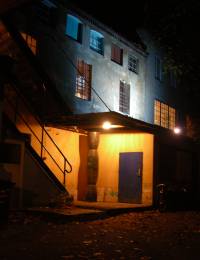Teresa Hackel und Cynthia Gonzalez: Zement-warmer-Grund
Dresden, 5 November 2005
Six weeks have passed since I saw the performance, but browsing through the photos brings it back so vividly that I even recall the music. Amazing power of visual memory! Writing about dance without photos would be a futile endeavor to me.
Parallels and counterparts
The performance consists of four choreographies: A duo with a disassembled piece of furniture, a duo with plant pots and two short solos. The duos are counterparts in several ways. In the first, the dancers exploit the whole space provided by the stage, including its vertical dimension, while in the second they restrain themselves to one spot. In the first they dance parallel scenes without interacting (except at the end), while in the second they keep close body contact all time (again except for the end). The final scenes of both duos are related by a peculiar facial expression, which - apart from being detached and ostentatiously unpretty - convey something I could not really figure out. The use of space is antipodal in the final scenes in the same way as in the whole choreographies: the dancers posture at the highest spot they can reach in the first piece, while they lie on the floor, hiding behind the pots in the second.
How to move smoothly with a burden
The first performance starts with dancers hidden within a box made of two shelves. They step out of the box, disassemble it and hold the shelves in a steady contact with their bodies from now on. The bulky load and the way the dancers move it around with their bodies are the characteristic features of the piece. The smoothness of the movement is interrupted only once, when Cynthia Gonzalez pushes her shelf rudely and loudly into the middle of the stage, as if she were moving rubbish over a floor which she doesn't care about. At all other times the shelves are treated as companions: Gonzalez holds them on the lap, touches them cheek-to-cheek and in a surprising action lifts their sharp edges by her bare neck (first and second photo above).
In the second part the roles are reversed: instead of dancers carrying the shelves around, the shelves support the bodies, which swim in the air in a daring play of balance (third photos in the first set). Then the symmetry breaks down: Gonzalez exploits space in a series of steadily upwards developing poses while Hackel first watches and later follows her. At the end, Gonzalez helps Hackel to climb onto her shelf and the dancers' bodies come together for the first time.
Aiming higher and higher towards the light, they finally reach the top, dangling there with an absentminded expression and eyes partially closed as if they were blinded by light.
Four-legged, four-armed creature in colorful light
In the second choreography dancers emerge from big plant pots, the same which Gonzalez used in her choreography Hungerpflanzen earlier this year.
In contrast to the first piece, the dancers assume close body contact immediately and keep it most of the time, creating a four-legged animal which is turning around and periodically repositioning its extremities. Light (Maik Blaum) paints the scene in three colors: The whole stage is covered with diffuse blue light, the bodies are illuminated a red spotlight and yellow light is coming in from outside through the window.
Solos
First the solos appear disconnected from the duos and from each other, but a closer look reveals a number of subtle interconnections. Gonzalez starts by embracing an imaginary object, large and light-weighted object. Then she alternates passages of dazzlingly fast movements bursting with energy with relaxed scenes expressing comforting emotions. She uses all available space in the same way as in the opening duo.
Hackel gets along without much locomotion, developing unusual body figures on the floor and simulating a large bird balancing on its toes low over the ground. Her figures are static, sophisticatedly architectonical and free of emotions.
You need sharp eyes to get all the goodies she is serving: would you notice that she is touching the ground by her knees and forehead only, floating her feet in the air?
The music by Moritz Töpfer consists of isolated, unpredictable piano sounds. The trick is to arrange apparently unconnected tones into sequels which stand on their own, self-contained without a need for melody or rhythm. If Töpfer has not borrowed this idea (maybe even some material) from Pierre Boulez's Troisième Sonate Pour Piano, it is a remarkable coincidence. In any case the music is both appealing by its own virtue and goes well with the dance.
 Where is "Blaue Fabrik"?
Where is "Blaue Fabrik"?
"Blaue Fabrik" seems to be an insider tip. Located at the far end of the students' and alternative lifestyle freaks' quarter Neustadt in Dresden and concealed in a backyard, it is easy to miss. The room was full (more than thirty people don't fit in), indicating that insiders know the place. Among them quite a few dancers, including Nicole Meier who I invariably see in the audience - if not on the stage - whenever I attend a dance performance in Societaetstheater, Projekttheater or Kleine Szene in Dresden.
(Petr Karlovsky)